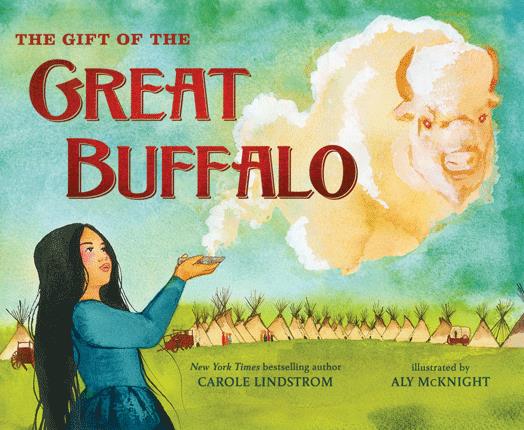| Gift of the great buffalo Author: Lindstrom, Carole | ||
| Price: $23.78 | ||
Summary:
Rose, a young Metis-Ojibwe girl, travels far with her family for the biannual buffalo hunt made up of hundreds of other families like hers. But the buffalo population has dwindled, and after days on the hunt, there are no buffalo to be found. Can Rose help her family find the herd that will enable them to survive the long winter?
| Illustrator: | McKnight, Aly |
Reviews:
Kirkus Reviews (+) (03/01/25)
School Library Journal (02/01/25)
Booklist (+) (00/12/24)
The Bulletin of the Center for Children's Books (00/12/24)
The Hornbook (00/03/25)
Full Text Reviews:
Other - 11/04/2024 In a time after "the arrival of the settlers and their iron horses... eliminated most of the buffalo," Rose’s family gathers with hundreds of other M?tis families for a biannual buffalo hunt. Her father, for the first time a captain of the event, has helped to plan it to ensure order and fairness. After a week of hunting, though, Pa sounds discouraged about the lack of buffalo, and Rose-despite her father’s instructions to remain with Ma-leaves camp to scout, donning Pa’s spare wolf skin. Sensate text from Anishinaabe/M?tis author Lindstrom (Autumn Peltier, Water Warrior) describes the effort: "As Rose tracked the buffalo, she began to think of herself as the wolf. She sniffed the dirt and the grasses as she prowled, sensing mashkode-bizhiki were near." The child’s efforts result in a good hunting day, and hope of her involvement in hunts to come. Watercolor and graphite illustrations from McKnight (Why We Dance), an enrolled member of the Shoshone-Bannock Tribes, incorporates glowing landscapes throughout this engaging account of prairie life. Back matter includes an author’s note and a history of the buffalo hunt. Ages 4-8. Author’s agent: Kathleen Rushall, Andrea Brown Literary. (Feb.) - Copyright 2024
School Library Journal - 02/01/2025 K-Gr 3—As the title suggests, this story depicts the Métis on a buffalo hunt. After several days with no success, Rose follows her pa when he sets out early in the morning. She rides her horse all day long, even worrying about losing her way back to camp. When Rose eventually finds buffalo, she leads the men from camp to them. Because she disobeyed her pa about joining him on the hunt, Rose is assigned her least favorite task of tanning the hide. The illustrator uses watercolor and graphite to complement the story. The pictures provide realistic views of camp and show the true meaning of ideas such as the "iron horse" with a full-page drawing of a train. Lindstrom, an enrolled citizen of the Ojibwe and Métis, states in her author's note that this is her version of Laura Ingalls Wilder's "Little House" books. The story is written with a similar style and fits into the same time period, building an authentic picture of life in 1880s America. VERDICT This is a great volume for bringing an authentic First Nation voice to a historical period.—Tara Rollins - Copyright 2025 Publishers Weekly, Library Journal and/or School Library Journal used with permission.



